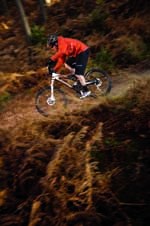 FRAME
FRAME
All Rush models share the same frame, with a monocoque carbon front triangle and aluminium shock mount, main pivot bearing cups and bottom bracket shell all integrated into the carbon.
But you only have to look at the weights of the other bikes in this test to see that the carbon isn’t offering any major weight saving.
The Rush frame has identical geometry to last year but the addition of the longer travel and taller Fox F120mm fork slackens the head angle by 1.5deg and raises the bottom bracket by approx 0.5in. So the bike’s geometry has changed — even if the frame’s hasn’t.
Just don’t be tempted to buy one of the more expensive Rush bikes without test riding it, as the Lefty-equipped bikes have steeper geometry and incredibly low bottom brackets.
The swingarm on the Rush is made from 6000 series aluminium and there is a small bridge bolted between the mainstays to improve stiffness. It’s similar to the bridge found on the seatstays of the original Santa Cruz Superlight — the idea being that lighter riders can remove it to save weight. It can also be removed for better mud clearance if desired. Even with the elevated swingarm there is a lot of chain slap on the Rush 4.
SUSPENSION
As far as single pivots go the Rush has one of the best pivot locations. It offers a little bit of chain torque in the middle ring for improved pedalling efficiency, but allows the suspension to work freely on high speed terrain when you shift up into the big ring.
Dropping into the granny ring does give a noticeable increase in pedalling feedback on rougher climbs, but it’s not as bad as some designs with higher pivot locations and even some linkage bikes.
At first glance the shock on the Rush 4 looks like a Float RP2 but it’s actually a custom shock with three settings: open, ProPedal and lockout — where the latter has a blow-off. Think Triad on the old Specialized Stumpy and you’ll get the idea. Even in the fully open position, if you stand up to sprint the ‘Dale responds by leaping into action and it definitely bobs less under hard pedalling efforts than the other bikes here. In fact it’s the only one that definitely doesn’t need a lockout shock.
BRAKES
Avid Juicy 5s lack the bite point adjuster of the more expensive 7s but you can still adjust it by removing the wheels and priming the pistons if you want to reduce lever throw. Whatever, overall performance of the Juicy 5s is excellent and they are still the brakes to beat.
PERFORMANCE
Even with the taller fork, the Rush 4 still has the lowest bottom bracket height on test at 13in dead. With 25 per cent sag we’re pleased to say that there is sufficient pedal clearance, but you won’t be able to pedal through every situation and don’t be tempted to run sub 2.0in tyres.
Out of the box, the Cannondale has the most neutral riding position on test. In fact with the 90mm stem and the seatpost head positioned in the middle of the saddle rails the position feels pretty similar to the longer-travel Prophet. There is plenty of room up front without upsetting the balance of the bike and the tight back end makes lofting the front a breeze. Grip is evenly distributed between both tyres and to say that the Rush has impeccable trail manners is an understatement. Using carbon for the front triangle gives such good steering accuracy that the rear struggles to match. Even with a fishtailing rear end the Rush 4 still transmits power to the rear wheel better than the other bikes here.
VERDICT
With the Rush 4, Cannondale has managed to capture, or it could be argued that it has actually stumbled across, the elusive mix of geometry that makes for a great-handling bike. It’s fast, positive and responsive in every situation and what really sold it to us is that the position on the Rush 4 instantly feels like how we’d set-up one of our own bikes. Pedal clearance is borderline, though, so it won’t be for everyone.
MBR RATING 9/10



